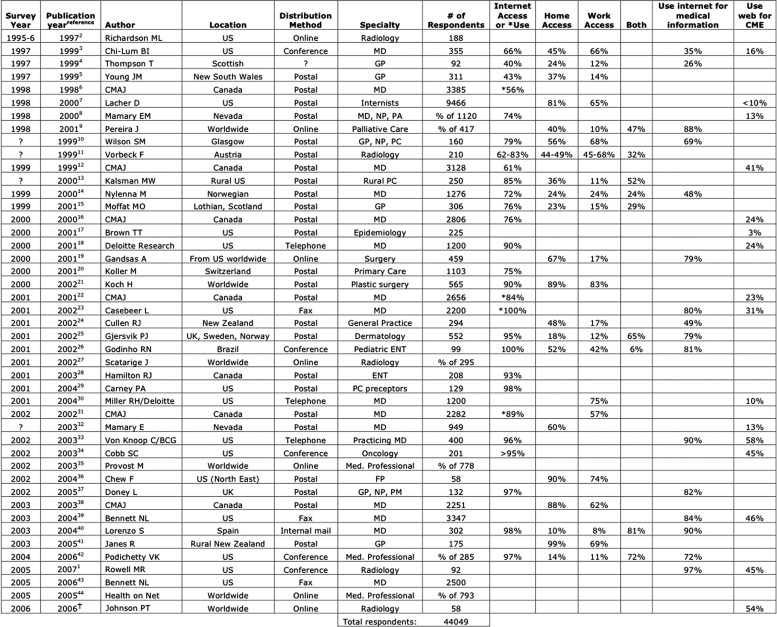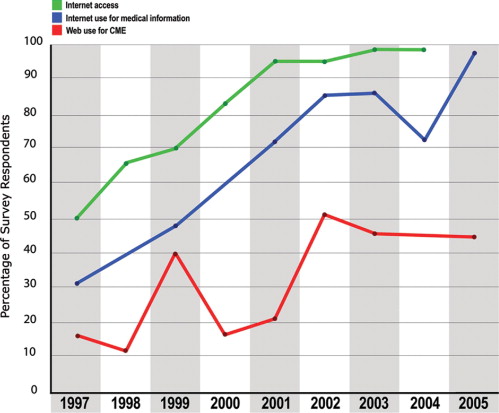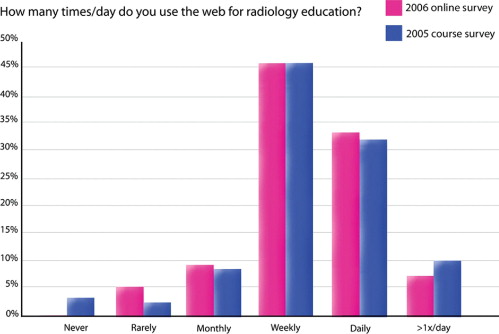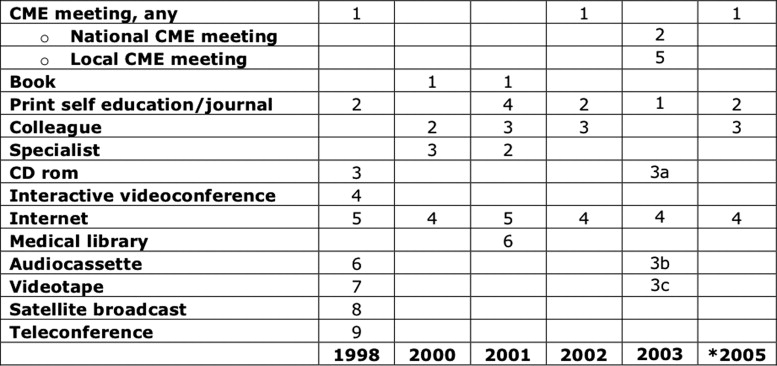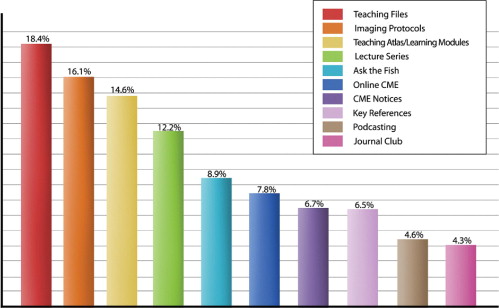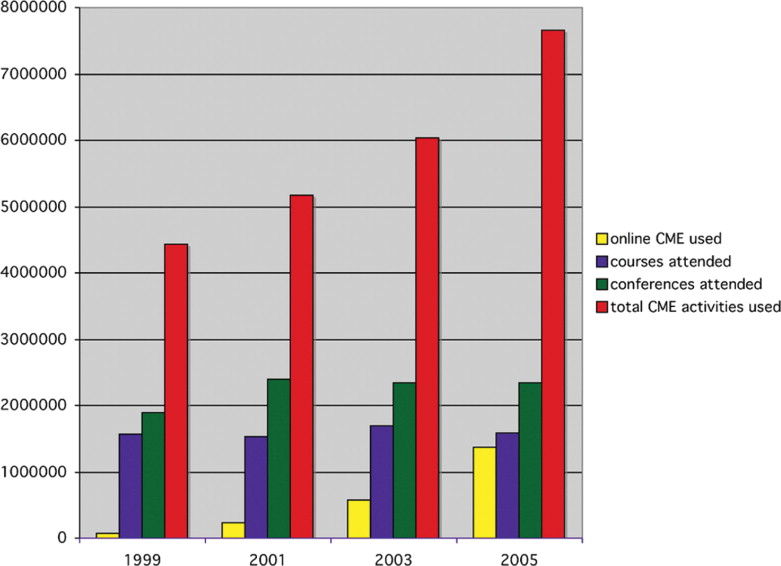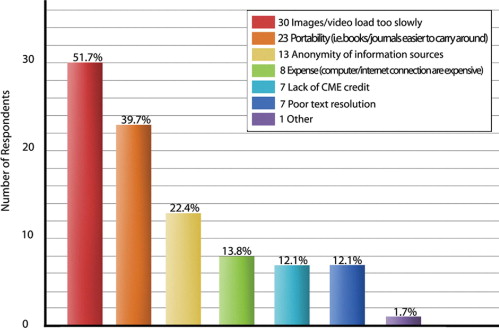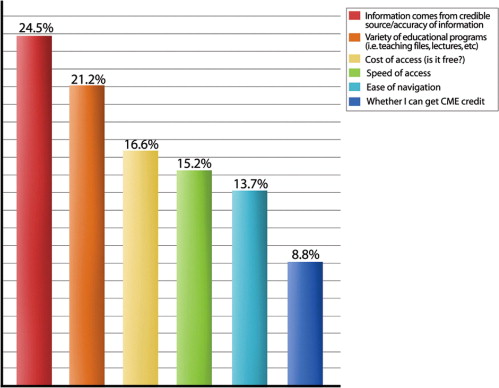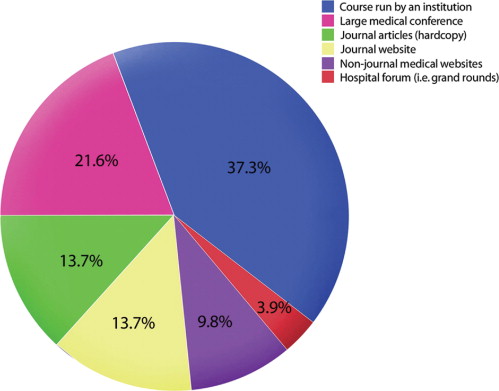Introduction
As a profession driven by technologic advancement, medicine was destined to embrace the Internet. Progressive growth in availability and speed has increased Internet utilization in research, practice, and education. This review focuses on the use of the World Wide Web (Web) for education by practicing physicians. Particularly in radiology, where workloads are increasing, the Web represents a readily available educational resource for physicians with limited time. However, survey data from 2005 revealed that traditional educational resources are preferred by radiologists for both information retrieval and continuing medical education (CME) ( ). Accordingly, we sought to evaluate patterns of internet utilization for information seeking and use of web-based resources for CME over time, in an attempt to delineate how Web-based educational programs can best serve physicians.
Literature Search: Methods
A broad search of PubMed was performed using the words “physician” and “Internet” to include all English language publications between January 1, 1996, and July 1, 2006. This produced 1,359 publications; the title, abstract, or article text was reviewed to select only those studies that surveyed practicing physicians with respect to their Internet use for medical information seeking or medical education. A cutoff of at least 50 respondents was applied, and any study that represented subgroup analysis of a previous investigation was not considered separately ( n = 3), to yield a total of 29 studies that fulfilled the criteria.
Cognizance of other pertinent publications that were not included in these results prompted additional searches using the following phrases in varying combinations: Internet, information seeking, World Wide Web, physician, radiology, education, medical education, continuing medical education, survey, questionnaire. In addition, a “related search” option was used with one model study, and any previous or subsequent pertinent survey data described in an identified study were retrieved. These methods produced an additional 14 studies. Added to this compilation were the data from two survey investigations performed by our computed tomography (CT) division in 2005 ( ) and 2006, which surveyed radiologists at CME courses ( ) and online, respectively. These most recent data come from an unpublished online survey posted on our Web site ( www.ctisus.com ) for 11 weeks between January and March 2006. A total of 212 radiology professionals participated, with responses from 58 radiologists referred to as “current data” throughout this review.
Literature Search: Results
Information from 45 survey investigations was analyzed ( Fig 1 ). The data available in these studies include responses from more than 44,000 physicians worldwide ( , current data). An effort was made to include surveys only involving physicians; however, 7 of the 45 had some non-physician medical professionals respond in addition to physicians ( ). For the purposes of this review, “Internet use” is defined as use of the Web for medical information retrieval or education, or the use of e-mail to consult colleagues.
The earliest survey was conducted between 1995 and 1996 ( ). For each subsequent year from 1997 through 2003, multiple investigations were identified, as well as at least one from 2004 and 2005 ( Fig 1 ). Four investigations did not indicate the year of distribution. All surveys analyzed were designed to study physician internet use for medical information retrieval or education. However, a variety of distribution methods were used, and the populations sampled were diverse ( Fig 1 ).
Findings
Internet Use for Information Retrieval and Education
Get Radiology Tree app to read full this article<
Get Radiology Tree app to read full this article<
Get Radiology Tree app to read full this article<
Get Radiology Tree app to read full this article<
Get Radiology Tree app to read full this article<
Get Radiology Tree app to read full this article<
Get Radiology Tree app to read full this article<
Get Radiology Tree app to read full this article<
Get Radiology Tree app to read full this article<
Get Radiology Tree app to read full this article<
Obstacles to Web-Based CME
Get Radiology Tree app to read full this article<
Get Radiology Tree app to read full this article<
Get Radiology Tree app to read full this article<
Get Radiology Tree app to read full this article<
Get Radiology Tree app to read full this article<
Get Radiology Tree app to read full this article<
Get Radiology Tree app to read full this article<
Optimizing the Design of Web-Based CME
Get Radiology Tree app to read full this article<
Get Radiology Tree app to read full this article<
Get Radiology Tree app to read full this article<
Get Radiology Tree app to read full this article<
Conclusions
Get Radiology Tree app to read full this article<
Acknowledgments
Get Radiology Tree app to read full this article<
References
1. Rowell M.R., Johnson P.T., Fishman E.K.: Radiology education in 2005: world wide web practice patterns, perceptions, and preferences of radiologists. Radiographics 2007; 27: pp. 563-571.
2. Richardson M.L., Norris T.E.: On-line delivery of continuing medical education over the world-wide web: an on-line needs assessment. AJR Am J Roentgenol 1997; 168: pp. 1161-1164.
3. Chi-Lum B.I., Durkin R.M.: Physicians accessing the internet: the PAI project. JAMA 1999; 282: pp. 633-634.
4. Thompson T., Sullivan F., Penny K.: Short communications. Health Bull 1999; 57: pp. 415-417.
5. Young J.M., Ward J.E.: General practitioners’ use of evidence databases. Med J Aust 1999; 170: pp. 56-58.
6. 1998 Physician resource questionnaire results. CMAJ http://www.cmaj.ca/cgi/content/full/159/5/525/DC1 . Accessed December 13, 2006.
7. Lacher D., Nelson E., Bylsma W., Spena R.: Computer use and needs of internists: a survey of members of the American College of Physicians–American Society of Internal Medicine. Proc AMIA Symp 2000; pp. 453-456.
8. Mamary E.M., Charles P.: On-site to on-line: barriers to the use of computers for continuing education. J Contin Educ Health Prof 2000; 20: pp. 171-175.
9. Pereira J., Bruera E., Quan H.: Palliative care on the net: an online survey of health care professionals. J Palliat Care 2001; 17: pp. 41-45.
10. Wilson S.M.: Impact of the internet on primary care staff in Glasgow. J Med Internet Res 1999; 1: pp. E7.
11. Vorbeck F., Zimmermann C., Vorbeck-Meister I., et. al.: Internet use in radiology: results of a nationwide survey. Eur J Radiol 1999; 31: pp. 141-151.
12. 1999 Physician resource questionnaire results. CMAJ (Canadian Medical Association). http://www.cmaj.ca/cgi/content/full/161/8/935/DC1 . Accessed July 14, 2006.
13. Kalsman M.W., Acosta D.A.: Use of the internet as a medical resource by rural physicians. J Am Board Fam Pract 2000; 13: pp. 349-352.
14. Nylenna M., Aasland O.G.: Physicians’ internet activities and their perceived coping with the medical information. Med Gen Med 2000; 2: pp. E7.
15. Moffat M.O., Moffat K.J., Cano V.: General practitioners and the internet—a questionnaire survey of internet connectivity and use in Lothian. Health Bull 2001; 59: pp. 120-126.
16. 2000 Physician resource questionnaire results. CMAJ (Canadian Medical Association) http://www.cmaj.ca/cgi/content/full/163/5/601/DC1 . Accessed July 14, 2006.
17. Brown T.T., Proctor S.E., Sinkowitz-Cochran R.L., et. al.: Physician preferences for continuing medical education with a focus on the topic of antimicrobial resistance: society for healthcare epidemiology of America. Infect Control Hosp Epidemiol 2001; 22: pp. 656-660.
18. Hoppszallern S.: Physicians and the internet: taking the pulse. Hosp Health Netw 2001; 75: pp. 51-57.
19. Gandsas A., Draper K., Chekan E., et. al.: Laparoscopy and the internet. Surg Endosc 2001; 15: pp. 1044-1048.
20. Koller M., Grutter R., Peltenburg M., et. al.: Use of the internet by medical doctors in Switzerland. Swiss Med Weekly 2001; 131: pp. 251-254.
21. Koch H., Dabernig J., Allert S., Puchinger M., Scharnagl E.: Plastic surgeons and the internet: results of a worldwide survey. Ann Plast Surg 2002; 49: pp. 466-471.
22. 2001 Physician resource questionnaire results. CMAJ (Canadian Medical Association) http://www.cmaj.ca/cgi/content/full/165/5/626/DC1 . Accessed July 14, 2006.
23. Casebeer L., Bennett N., Kistofco R., et. al.: Physician internet medical information seeking and on-line continuing education use patterns. J Contin Educ Health Prof 2002; 22: pp. 33-42.
24. Cullen R.J.: In search of evidence: family practitioners’ use of the internet for clinical information. J Med Libr Assoc 2002; 90: pp. 370-379.
25. Gjersvik P.J., Nylenna M., Aasland O.G.: Use of the internet among dermatologists in the United Kingdom, Sweden and Norway. Dermatol Online J 2002; 8: pp. 1.
26. Godinho R.N., Kamil S., Keogh I., et. al.: The internet—current trends and future expectations among Brazilian pediatricians and otolaryngologists with a special interest in pediatric otolaryngology. Int J Pediatr Otorhinolaryngol 2003; 67: pp. 729-732.
27. Scatarige J.C., Garland M.R., Corl F.M., et. al.: Visitors and content preferences on an educational web site dedicated to clinical body computed tomography: results of a 2001 audit and online survey. Invest Radiol 2002; 37: pp. 53-59.
28. Hamilton R.J., Pinto T., Carr M.M.: Internet-based continuing medical education in otolaryngology: a survey of Canadian otolaryngologists. J Otolaryngol 2003; 32: pp. 239-244.
29. Carney P.A., Poor D.A., Schifferdecker K.E., et. al.: Computer use among community-based primary care physician preceptors. Acad Med 2004; 79: pp. 580-590.
30. Miller R.H., Hillman J.M., Given R.S.: Physician use of the IT: results from the Deloitte research survey. J Healthc Inf Manage 2004; 18: pp. 72-80.
31. 2002 Physician resource questionnaire results. CMAJ (Canadian Medical Association) www.ecmaj.com/cgi/content/full/167/5/521/DC1 . Accessed December 13, 2006.
32. Mamary E., Charles P.: Promoting self-directed learning for continuing medical education. Med Teach 2003; 25: pp. 188-190.
33. Von Knoop C, Lovich D, Silverstein MB, et al., for the Boston Consulting Group. Detailed report on physician and patient use of the web. Vital signs: E-health in the United States. http://www.bcg.com/publications_splash.jsp Accessed October 17, 2006.
34. Cobb S.C.: Comparison of oncology nurse and physician use of the internet for continuing education. J Contin Educ Nurs 2003; 34: pp. 184-188.
35. Provost M., Perri M., Baujard V., et. al.: Opinions and e-health behaviours of patients and health professionals in the U.S.A. and Europe. Stud Health Technol Inform 2003; 95: pp. 695-700.
36. Chew F., Grant W., Tote R.: Doctors on-line: using diffusion of innovations theory to understand internet use. Fam Med 2004; 36: pp. 645-650.
37. Doney L., Barlow H., West J.: Use of libraries and electronic information resources by primary care staff: outcomes from a survey. Health Info Libr J 2005; 22: pp. 182-188.
38. 2003 Physician resource questionnaire results. CMAJ (Canadian Medical Association) http://www.cmaj.ca/cgi/content/full/169/7/701/DC1 . Accessed December 13, 2006.
39. Bennett N.L., Casebeer L.L., Kristofco R.E., et. al.: Physicians’ internet information seeking behaviours. J Contin Educ Health Prof 2004; 24: pp. 31-38.
40. Lorenzo S., Mira J.J.: Are Spanish physicians ready to take advantage of the internet?. World Hosp Health Serv 2004; 40: pp. 31-43.
41. Janes R., Arroll B., Buetow S., et. al.: Few rural general practitioners use the internet frequently in regard to patient care. N Z Med J 2005; 118: pp. U1380.
42. Podichetty V.K., Booher J., Whitfield M., et. al.: Assessment of internet use and effects among healthcare professionals: a cross sectional survey. Postgrad Med J 2006; 82: pp. 274-279.
43. Bennett N.L., Casebeer L.L., Zheng S., et. al.: Information-seeking behaviors and reflective practice. J Contin Educ Health Prof 2006; 26: pp. 120-127.
44. Analysis of 9th HON survey of health and medical internet users. Winter 2004–2005. http://www.hon.ch/Survey/Survey2005/res.html . Accessed November 2, 2006.
45. ACCME annual report data, 1999. http://www.accme.org/dir_docs/doc_upload/c4109658-bc0a-4bfa-9de1-e30ecee87239_uploaddocument.pdf . Accessed April 5, 2007.
46. ACCME annual report data, 2001. http://www.accme.org/dir_docs/doc_upload/5b064cdd-0e78-42b9-a07e-f802ee36f032_uploaddocument.pdf . Accessed April 5, 2007.
47. ACCME annual report data 2003. http://www.accme.org/dir_docs/doc_upload/97dd7a39-9746-4a5d-8c01-e56a9ffc0c8b_uploaddocument.pdf . Accessed April 5, 2007.
48. ACCME annual report data 2005. http://www.accme.org/dir_docs/doc_upload/9c795f02-c470-4ba3-a491-d288be965eff_uploaddocument.pdf . Accessed April 5, 2007.
49. American Medical Association. The physician’s recognition award and credit system. 2006 revision. http://www.ama-assn.org/ama1/pub/upload/mm/455/pra2006.pdf#page=4 . Accessed October 2, 2006.
50. Aparicio A., Willis C.E.: The continued evolution of the credit system. J Contin Educ Health Prof 2005; 25: pp. 190-196.
51. McKibbon K.A., Fridsma D.B.: Effectiveness of clinician-selected electronic information resources for answering primary care physicians’ information needs. J Am Med Inform Assoc 2006; 13: pp. 653-659.
52. Staunton M.: Evidence-based radiology: steps 1 and 2—asking answerable questions and searching for evidence. Radiology 2007; 242: pp. 23-31.
53. Dodd J.D.: Evidence-based practice in radiology: steps 3 and 4—appraise and apply diagnostic radiology literature. Radiology 2007; 242: pp. 342-354.
54. Halligan S., Altman D.G.: Evidence-based practice in radiology: steps 3 and 4—appraise and apply systematic reviews and meta-analyses. Radiology 2007; 243: pp. 13-27.
55. Patel M.R., Schardt C.M., Sanders L.L., et. al.: Randomized trial for answers to clinical questions: evaluating a pre-appraised versus a MEDLINE search protocol. J Med Libr Assoc 2006; 94: pp. 382-387.
56. Kahn C.E., Ehlers K.C., Wood B.P.: Radiologists’ preferences for just-in-time learning. J Dig Imaging 2006; 19: pp. 202-206.
57. Kahn C.E., Santos A., Thao C., et. al.: A presentation system for just-in-time learning in radiology. J Dig Imaging 2007; 20: pp. 6-16.
